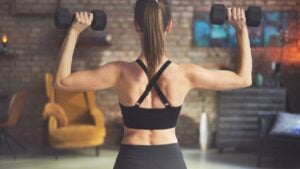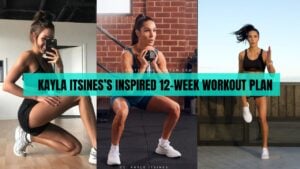If you love lifting barbells and want to integrate some of the best pull exercises into your training plan, you’ve come to the right place.
In this article, I’ll show you the best barbell pull exercises for building strength, muscle mass, and endurance and helping you build an aesthetic body.
Compound Pull Exercises for Strength Building:
- Deadlift
- Bent-over Row
- Barbell T Row
Isolation Pull Exercises for Muscle Gain:
- Seal Row
- Barbell Shrug
- Meadows Row
- Biceps Curl
- Wrist Curl
- Upright Row
Pull Exercises for Power and Endurance:
- Pendlay Row
- Barbell Hang Clean
What Are Pull Exercises?
Pull exercises involve lifting the barbell from the floor (for example, a deadlift), pulling the bar toward the body (bent-over row), and flexing your arms (biceps curl).
The barbell pull workouts work on multiple parts throughout the body, particularly the back, biceps, and shoulders.
3 Best Barbell Pull Exercises for Building Strength
Deadlift, bent-over row, and T-bar row are three compound exercises you can utilize to develop lifting ability while building muscle.
1. Deadlift

The deadlift is a strength-building exercise that simultaneously bolsters various upper and lower body muscles, primarily the hamstrings, glutes maximus, quadriceps, and back.1 Martín-Fuentes I, Oliva-Lozano JM, Muyor JM. Electromyographic activity in deadlift exercise and its variants. A systematic review. PLoS One. 2020 Feb 27;15(2):e0229507. doi: 10.1371/journal.pone.0229507. PMID: 32107499; PMCID: PMC7046193.
It helps enhance your lifting capability, strengthen joints and bones, promote hypertrophy, and build a resilient body.
I believe it is one of the exercises you need to learn as early as possible if you want to grow your strength and take your fitness to the next level.
How to do a Deadlift:
Set up:
- Place the bar on the floor and insert the appropriate weight into it.
- Wear a weightlifting belt and stand in a shoulder-width stance, with your feet under the middle of the bar and your shin close to it. Your toes should be pointed forward or slightly outward.
- Bending your hips and knees, lean forward toward the bar.
- Grip the barbell with an alternate grip, placing your hands slightly wider than shoulder-width apart with arms straight and just outside the knees.
- Now, lower the hips down by allowing the knees to move forward until the shins touch the bar. Make sure your back remains flat throughout. That’s the starting position.
Execution:
- Keeping your abdominal muscles engaged and arms extended, take a deep breath and lift the bar with your full strength by extending your hips and knees.
- Keep driving through your feet until your hips come forward into the standing position.
- Exhale and lower the barbell in the starting position. Your spine and head should be neutral until you return the bar to the floor.
Recommended reps and sets: Start with light weights during the first couple of sets and perform five to eight reps each. Then, increase the load in your following sets and perform two to four reps.
2. Bent-Over Barbell Row

The bent-over barbell row helps build a strong back. It stimulates the latissimus dorsi, trapezius, erector spine, and supraspinatus and helps develop a strong and sizeable torso.2 Fenwick CM, Brown SH, McGill SM. Comparison of different rowing exercises: trunk muscle activation and lumbar spine motion, load, and stiffness. J Strength Cond Res. 2009 Mar;23(2):350-8. doi: 10.1519/JSC.0b013e3181942019. PMID: 19197209
Besides the back muscles, your biceps, abdominals, and shoulders also work during the barbell row, making it a staple strength and muscle-building exercise.
How to Perform a Bent-over Barbell Row:
Setup:
- Put the appropriate bar into a barbell and grasp it with an overhand grip, placing the hands just outside your hips. Stand straight with your feet shoulder-width apart.
- Pushing your hips, softly bend your knees, and slightly lean forward.
- Keep your arms straight downward, core tight, and chest up. That’s the start.
Execution:
- Pull the barbell toward you until it reaches close to your lower abs.
- Contracting your back muscles, pause for a moment and then return to the start.
Recommended reps and sets: Perform 15 reps with light weights in your first set, increase the weight in your second and third sets, and do eight to 12 reps.
3. Close Grip Barbell T Row
The barbell T-row is another pull exercise that involves lifting the weight off the floor and pulling it toward your body.
It engages multiple body parts, from the lats and traps to the biceps and abs, and helps build a wider back and a strong torso.
Close Grip T row also helps scale your deadlift 1RM and improves your powerlifting.
How to do a Close Grip T Row:
Set up:
- Position one end of the barbell in the corner of the wall and put the suitable weight into another end.
- Stand between the barbell with your feet shoulder-width apart. The bar should be landed between your legs.
- Place a V-grip bar under the bar, usually below the weight plates. Hold the handles firmly with your palms facing each other.
- Hinge forward at your hips and maintain a slight bend in your knees.
Execution:
- Brace your abdominal muscles and pull the bar toward your torso until the bar is close to your stomach. Keep your arms straight and your back flat.
- Contracting your back muscles, wait for a moment, and then lower to the start.
Recommended reps and sets: Perform 3 to 4 sets of 6-12 reps. Start with lightweight and perform 15-20 reps in the first (warm-up) set. From the second set, start putting 15-20% more weight until your last set.
5 Best Pull Day Barbell Exercises for Building Muscle
In this section, I’ll share those exercises that do not work on multiple body parts at the same time. Instead, they focus on only one or two muscle groups to help bring out the best shape and improve symmetry.
1. Barbell Seal Row
The barbell seal row reinforces the posterior deltoids and trapezius and develops a firm torso.
It involves lying prone on the bench and holding the bar with straight arms without touching the floor.
This position minimizes lower back involvement, making it suitable for people who can’t do bent-over rows properly.
How to do a Barbell Seal Row:
Set up:
- Place the barbell on the floor and position the legs of a weight bench on the blocks. The bar should be underneath the bench.
- Lie on the bench with your face down and legs straight.
- Extend your arms and grasp the barbell with an overhand grip, hands slightly wider than shoulder-width apart.
Execution:
- Inhale and pull the bar toward you until it reaches close to the bench.
- Squeeze your back muscles, pause momentarily, and then extend your elbows.
Recommended reps and sets: Perform three sets of 15 reps each. Lift as heavy as your body allows, but make sure you don’t feel breathing difficulty.
2. Barbell Shrug
The barbell shrug is an effective way to add size and strength to your upper back muscles and shoulders.3 Pizzari, Tania et al. “Modifying a shrug exercise can facilitate the upward rotator muscles of the scapula.” Clinical biomechanics (Bristol, Avon) vol. 29,2 (2014): 201-5. doi:10.1016/j.clinbiomech.2013.11.011
It also engages various stabilizer muscles, which are often skipped during other exercises.
If done correctly, this will improve stability around your neck and traps as well as correct poor posture.
How to do a Barbell Shrug:
Set up:
- Grab a loaded barbell with an overhand grip and stand straight with your feet hip-width apart.
- Hold the bar against your thigh with your arms straight, palms facing in, and your hands just outside your sides. That’s the start.
Execution:
- Pull your shoulder blades toward your ears as high as possible, keeping your arms straight,
- Squeeze your muscles for a couple of seconds, then relax your shoulder blades and repeat.
Recommended reps and sets: Perform four sets of 8-12 reps with 2-3 seconds of pause at the top during each rep.
3. Meadows Row
I’ve seen many people struggle to lift equal weight with each hand. Feeling one arm dominating the other is a common issue among lifters, however, not working on this issue can lead to strength imbalance and injuries.
To help address this issue, you should integrate single-arm exercises into your workout routine, such as the Meadow Rows (in the case of barbell training).
The Meadows row is a unilateral workout that allows you to work on one side of the back at a time, helps correct strength imbalances, and builds a proportional back.
How to do a Meadow Row:
Set-up:
- Position one end of the barbell in the corner of the wall and put the suitable weight into another end.
- Stand in the split stance and bend forward to grab the bar with an overhand grip with your left hand.
- Place your right on your right knee for support. That’s the start.
Execution:
- Drive your elbow at your side until your back muscles are contracted.
- Pause momentarily, feel the contraction, then lower the barbell to the start.
Recommended reps and sets: Perform 3 sets of 10-15 reps. Aim for higher sets or reps to train the weaker side.
4. Barbell Biceps Curl

The barbell curl is a favorite exercise for almost everyone who wants to build bigger and stronger biceps.
It engages both the long and short heads of the biceps. Sturdy biceps improve the shape of your arms and enhance your lifting and pulling performance.
How to do a Barbell Bicep Curl:
Set up:
- Grasp a loaded barbell with an underhand grip with your hands hip to shoulder-width apart.
- Stand straight in a hip-width stance, keeping your arms straight in front of your thigh with your palms facing up.
Execution:
- Curl your arms until your biceps are fully contracted.
- Pause for a moment and then uncurl your arms and repeat.
Recommended reps and sets: Perform three sets of 10-12 reps. Train your biceps after the back on your barbell pull day.
5. Barbell Wrist Curl
Forearms are usually activated during the various biceps curls, but sometimes, you need to work on it specifically. And for that, you can do barbell wrist curls.
Barbell wrist curls are an effective exercise for forging your forearms and improving wrist flexion strength for both grip and stability.
You can do barbell wrist curls in various ways, such as seated or bent-over. Depending on your comfort, you can do the one that suits you the most.
How to Do a Bent-over Wrist Curl:
Set up:
- Grab a loaded bar with your hands hip-width apart.
- Bend your knees, push your hips back, lean forward, and place your elbows on your upper thigh. Your wrists will be hanging off the floor. That’s the start.
Execution:
- Keep your abs tight, maintain a straight back, and curl your wrists until your forearms are entirely engaged.
- Feel the work momentarily, then return to the start.
Recommended reps and sets: You can do three sets of 15 reps each with moderate weight. Take the rest period between sets as short as possible. Do this exercise after hammering your biceps.
6. Upright Row
The upright row involves holding the bar down with straight arms and then pulling it up toward your neck. It simultaneously strengthens the deltoids and upper back and helps build a strong and functional upper body.4 McAllister MJ, Schilling BK, Hammond KG, Weiss LW, Farney TM. Effect of grip width on electromyographic activity during the upright row. J Strength Cond Res. 2013;27(1):181-187. doi:10.1519/JSC.0b013e31824f23ad
However, studies also suggest doing the upright row incorrectly produces subacromial impingement (painful shoulder condition).5 Schoenfeld, Brad & Kolber, Morey & Haimes, Jonathan. (2011). The Upright Row: Implications for Preventing Subacromial Impingement. Strength & Conditioning Journal. 33. 25-28. 10.1519/SSC.0b013e31822ec3e3.
The study also suggested that you can minimize the risk of shoulder impingement by keeping your elbows below your shoulder level at the top.
How to Do an Upright Row:
Set up:
- Grab a loaded barbell with your hands slightly wider than shoulder apart.
- Keep the barbell close to your thigh with your arms extended.
- Slightly lean forward without bending your back. That’s the start.
Execution:
- Driving your elbows up and out, pull the bar toward your neck until your traps and shoulders are engaged and your elbows are at shoulder level.
- Squeeze for a moment, then return to the start. Avoid driving your elbows beyond your shoulder level.
Recommended reps and sets: Do three to four sets of 10-12 reps in a slow and deliberate manner, feeling the contraction in your back and shoulders.
Top 2 Barbell Pull Exercises to Build Power and Endurance
In this section, I’ll show you the top two barbell exercises that help build power and endurance and improve your athletic fitness.
These exercises involve quick pull movements, requiring you to act faster than normal.
1. Pendlay Row
The Pendlay row is an explosive barbell exercise that targets multiple muscles at once, particularly the upper back and posterior delt. It is a great way to maximize strength, power, and explosiveness while building upper-body muscles.
It involves lifting the bar from the floor every single rep. This can also be used as a substitute for the bent-over row.
How to Do a Pendlay Row:
Set up:
- Place a loaded barbell on the floor. Stand close to it, feet shoulder-width apart, and shin close to the bar.
- Push your hips back and bend your knees until your torso is parallel to the floor.
- Extend your arms and grip the bar with an overhand grip. Your elbows will be just outside the knees.
- Your hips, knees, and lower back will be in a fixed position. That’s the start.
Execution:
- Keeping your core tight, quickly pull the bar off the floor with your arms until it reaches your upper or middle stomach.
- After a second pause, lower the bar to the floor and again pull it explosively.
Recommended reps and sets: Perform three to four sets of 15 reps. It is a high-intensity exercise, so you should do it as quickly as possible.
2. Barbell Hang Clean
The barbell hang clean builds explosiveness, power, and balance and simultaneously improves aerobic and anaerobic fitness.
It also annihilates the significant calories in a short time and builds endurance.
How to Do a Barbell Hang Clean:
Set up:
- Grab a loaded barbell with an overhand grip with your hands shoulder-width apart and stand upright.
- Keep your arms straight so the bar is in front of your thighs. Maintain a tight core. That’s the start.
Execution:
- Slightly bend your knees (to generate power) and use your hip and knee to clean the bar over your shoulder. Pull the bar upward while keeping your elbows high.
- Drop into a partial squat to catch the bar at shoulder height.
- Extend your knees to stand up back. That’s one rep.
Recommended reps and sets: Perform five sets of 10 reps each. Start with an empty barbell and put a lightweight after each set.
Finishing it Off
The barbell is free-weight exercise equipment that provides a full range of motion and helps you lift light to heavy weights.
From the deadlift, bent-over row, and Pendlay row to shoulder shrug, Meadows row, and biceps curl, you can do as many as 11 best pull exercises with barbells to maximize your strength, endurance, and muscle growth.
- Deadlift: Target legs, glutes, and back and build a strong and functional body.
- Bent-over Row: Hammer every muscle of the back and develop a broad torso.
- Barbell T Row: Engage the lats, traps, and biceps, and build strength and muscle mass.
- Seal Row: Strengthen the rear delt and upper back without stressing the lower back.
- Barbell Shrug: Build strength and mobility around the shoulder and improve posture.
- Meadows Row: Train each side of the back individually and improve strength imbalance and muscular symmetry.
- Biceps Curl: Isolate the biceps’ short and long heads and build strong and aesthetic upper arms.
- Wrist Curl: Bolster lower arms, build huge forearms, and improve wrist mobility.
- Upright Row: Strengthen deltoids and upper traps and help build a defined upper body.
- Pendlay Row: Improve strength, power, and explosiveness while developing upper-body muscles.
- Hang Clean: Build explosiveness, power, and muscle and improve athletic fitness simultaneously.
Whichever exercise you perform, make sure you do it in the right form to avoid unwanted injuries.
References
- 1Martín-Fuentes I, Oliva-Lozano JM, Muyor JM. Electromyographic activity in deadlift exercise and its variants. A systematic review. PLoS One. 2020 Feb 27;15(2):e0229507. doi: 10.1371/journal.pone.0229507. PMID: 32107499; PMCID: PMC7046193.
- 2Fenwick CM, Brown SH, McGill SM. Comparison of different rowing exercises: trunk muscle activation and lumbar spine motion, load, and stiffness. J Strength Cond Res. 2009 Mar;23(2):350-8. doi: 10.1519/JSC.0b013e3181942019. PMID: 19197209
- 3Pizzari, Tania et al. “Modifying a shrug exercise can facilitate the upward rotator muscles of the scapula.” Clinical biomechanics (Bristol, Avon) vol. 29,2 (2014): 201-5. doi:10.1016/j.clinbiomech.2013.11.011
- 4McAllister MJ, Schilling BK, Hammond KG, Weiss LW, Farney TM. Effect of grip width on electromyographic activity during the upright row. J Strength Cond Res. 2013;27(1):181-187. doi:10.1519/JSC.0b013e31824f23ad
- 5Schoenfeld, Brad & Kolber, Morey & Haimes, Jonathan. (2011). The Upright Row: Implications for Preventing Subacromial Impingement. Strength & Conditioning Journal. 33. 25-28. 10.1519/SSC.0b013e31822ec3e3.






